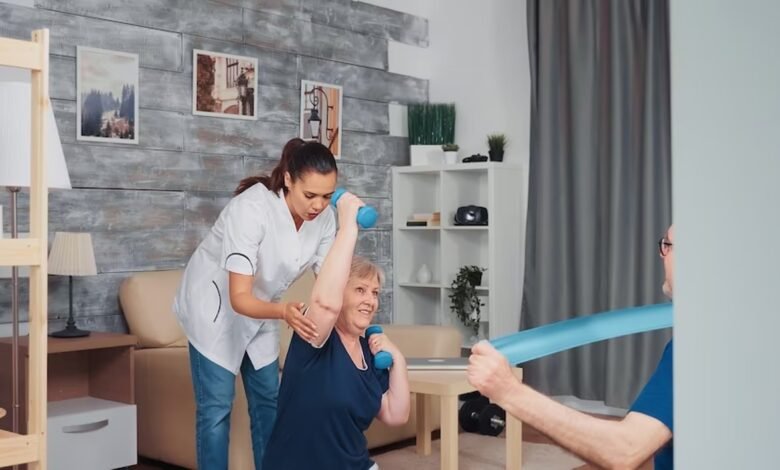Physical Therapy for Sports Injuries: A Comprehensive guide

Sports injuries are an unfortunate yet common occurrence among athletes of all levels. Whether you’re a professional athlete or someone who enjoys recreational sports, injuries can disrupt your active lifestyle. That’s where physical therapy comes into play, offering a comprehensive solution to help you recover and get back in the game. In this guide, we’ll explore the world of physical therapy for sports injuries, breaking down the essential aspects, benefits, and frequently asked questions.
Physical Therapy for Sports Injuries
Sports injuries are an inherent risk in the world of athletics. Whether you’re an avid runner, a weekend warrior on the basketball court, or a professional athlete, the possibility of getting injured during physical activity is ever-present. These injuries can range from minor sprains to more severe fractures, and they not only affect your physical health but can also have a significant impact on your mental well-being and overall quality of life.
The Role of Physical Therapy
Injury Assessment and Diagnosis
One of the initial steps in the journey of recovering from a sports injury is accurate assessment and diagnosis. When you consult a skilled physical therapist, they will perform a thorough evaluation to understand the extent of your injury. This evaluation may include physical examinations, imaging tests, and discussions about your medical history and lifestyle.
Once the injury is diagnosed, the physical therapist will work with you to develop a personalized treatment plan tailored to your specific needs. This plan will consider the type and severity of your injury, your fitness level, and your goals for recovery.
Tailored Treatment Plans
Physical therapists are experts in designing individualized treatment plans that focus on your unique injury and circumstances. These plans typically include a combination of therapeutic techniques, exercises, and modalities that aim to alleviate pain, improve mobility, and accelerate healing.
Read More:Physical Therapy For Your Body: The Health Benefits
Rehabilitation Exercises
One of the cornerstones of physical therapy for sports injuries is rehabilitation exercises. These exercises are carefully selected to target the affected area and gradually restore strength and function. They may include stretches, resistance training, balance exercises, and more. Your physical therapist will guide you through each exercise, ensuring proper form and technique.
In the next section, we’ll explore the most common sports injuries that can benefit from physical therapy.
Common Sports Injuries
Sprains and Strains
Sprains and strains are among the most prevalent sports injuries. A sprain involves the stretching or tearing of ligaments, which are the tough bands that connect bones to one another. On the other hand, strains affect muscles or tendons, which attach muscles to bones. Both can result in pain, swelling, and limited mobility.
Fractures and Dislocations
Fractures, or broken bones, can occur as a result of high-impact sports or accidents. Dislocations involve the displacement of bones from their normal positions. These injuries require immediate medical attention and often follow with a period of immobilization and rehabilitation.
Overuse Injuries
Overuse injuries develop gradually over time and are common in activities that involve repetitive motions, such as running or throwing. Conditions like tendinitis and stress fractures fall into this category. Physical therapy can help identify the root causes of overuse injuries and provide strategies to prevent them from recurring.
In the coming sections, we will delve deeper into the rehabilitation process, the benefits of physical therapy, and how to choose the right physical therapist for your needs.
The Rehabilitation Process
Now that we’ve established the crucial role of physical therapy in treating sports injuries, let’s take a closer look at the rehabilitation process itself.
Initial Evaluation
Your journey to recovery begins with an initial evaluation by a licensed physical therapist. During this assessment, the therapist will examine your injury, gather relevant medical history, and discuss your goals. This in-depth evaluation serves as the foundation for creating a tailored treatment plan that addresses your specific needs.
Goal Setting
Setting clear and achievable goals is an essential aspect of the rehabilitation process. Your physical therapist will work closely with you to define realistic milestones for your recovery. These goals will guide the therapy sessions and provide you with a sense of direction and motivation.
Therapeutic Techniques
Physical therapists employ a wide range of therapeutic techniques to promote healing and improve function. These techniques may include:
- Manual Therapy: Hands-on techniques such as massage and joint mobilization help reduce pain and improve mobility.
- Ultrasound and Electrotherapy: These modalities use soundwaves and electrical stimulation to enhance blood flow, reduce inflammation, and promote tissue repair.
- Exercise Prescription: Customized exercise programs are designed to strengthen muscles, improve flexibility, and restore normal movement patterns.
- Pain Management: Therapists may use various pain management strategies, such as hot and cold therapy, to alleviate discomfort.
Benefits of Physical Therapy
Faster Recovery
One of the primary benefits of physical therapy is its ability to expedite the recovery process. Through targeted exercises and therapeutic techniques, physical therapists can help you regain function and mobility more quickly than simply resting or attempting to heal on your own.
Preventing Recurrence
Physical therapists not only focus on healing your current injury but also work to prevent future recurrences. They assess your movement patterns and identify any weaknesses or imbalances that may have contributed to the injury. By addressing these issues, you can reduce the risk of reinjury.
Improved Performance
Athletes often find that, after undergoing physical therapy, they not only recover from their injuries but also perform better than before. This is because therapy helps optimize biomechanics, enhances strength and flexibility, and improves overall athletic performance.
Choosing the Right Physical Therapist
Selecting the right physical therapist is a crucial step in your recovery journey. Here are some factors to consider when making your choice:
Qualifications and Experience
Ensure that your physical therapist is licensed and has experience in treating sports-related injuries. Look for certifications or additional training in sports rehabilitation.
Compatibility and Communication
Effective communication and a good rapport with your therapist are essential. You should feel comfortable discussing your concerns and goals with them.
References and Reviews
Seek recommendations from friends, family, or your primary care physician. Additionally, check online reviews and testimonials to gauge the therapist’s reputation.
In the next sections, we will explore topics like at-home exercises, advanced therapies, and the critical role of nutrition and mental health in the recovery process.
At-Home Exercises and Self-Care
While your sessions with a physical therapist are crucial, the work doesn’t stop there. Continuing exercises and self-care practices at home play a significant role in your recovery. Your therapist will provide you with a personalized home exercise program that complements your in-clinic treatment.
Advanced Therapies
In some cases, advanced therapies may be recommended to enhance your recovery. These can include:
- Manual Therapy: Therapists may use specialized techniques like myofascial release or joint manipulation for specific conditions.
- Ultrasound and Electrotherapy: These modalities may be incorporated into your treatment plan for enhanced pain relief and tissue healing.
- Aquatic Therapy: Water-based exercises in a pool can reduce joint stress and improve mobility, making them particularly beneficial for certain injuries.
When Surgery Is Necessary
While physical therapy can often be a stand-alone treatment, there are instances where surgery is necessary to fully address a sports injury. Physical therapists work closely with surgeons to ensure a seamless transition from surgery to rehabilitation. Post-surgery rehabilitation is a crucial phase that focuses on rebuilding strength and function.
Nutrition and Sports Injuries
Nutrition plays a pivotal role in the healing process. Consuming a balanced diet rich in vitamins, minerals, and protein can accelerate recovery. Additionally, staying hydrated is essential for tissue repair and overall well-being.
Mental Health and Injury Recovery
Injuries can take a toll not only on your body but also on your mental health. Dealing with pain, setbacks, and the fear of reinjury can be challenging. Physical therapists often address the psychological aspects of recovery, helping you stay motivated and mentally resilient throughout the process.
Preventing Sports Injuries
While recovering from a sports injury is essential, preventing them in the first place is equally crucial. Here are some preventive measures:
- Warm-Up and Cool Down: Properly warming up and cooling down before and after physical activity can reduce the risk of injuries.
- Proper Equipment: Ensure you have the right gear and equipment for your sport or activity, including protective gear like helmets and pads.
- Technique and Form: Learn and practice proper techniques to minimize stress on your body.
Case Studies
Real-life success stories can be incredibly motivating. In this section, we’ll share stories of individuals who have successfully recovered from sports injuries with the help of physical therapy.
Read More:6 Things to Start 2022 Mentally and Physically Strong
Conclusion
In conclusion, physical therapy is a comprehensive and effective approach to recovering from sports injuries. It offers numerous benefits, including faster recovery, reduced risk of recurrence, and improved athletic performance. Choosing the right physical therapist and actively participating in your rehabilitation are key to a successful recovery journey.
Remember that sports injuries are a part of an athlete’s life, but they don’t have to sideline your passion for sports. With the guidance and expertise of a skilled physical therapist, you can bounce back stronger and continue pursuing your athletic goals.
FAQs
What types of injuries can physical therapy treat?
Physical therapy can treat a wide range of injuries, including but not limited to sprains, strains, fractures, dislocations, overuse injuries, and post-surgery rehabilitation.
How long does the recovery process usually take?
The duration of the recovery process varies depending on the type and severity of the injury. Some individuals may see significant improvement in a few weeks, while others may require several months of therapy.
Is physical therapy suitable for chronic injuries?
Yes, physical therapy can be beneficial for chronic injuries. It can help manage pain, improve function, and enhance the quality of life for individuals with long-term conditions.
Can I do my physical therapy exercises at home?
Yes, your physical therapist will provide you with a customized home exercise program to complement your in-clinic sessions. Consistency with these exercises is essential for a successful recovery.
Are there any age restrictions for undergoing physical therapy?
No, there are no age restrictions for undergoing physical therapy. It can benefit individuals of all ages, from children to seniors.







